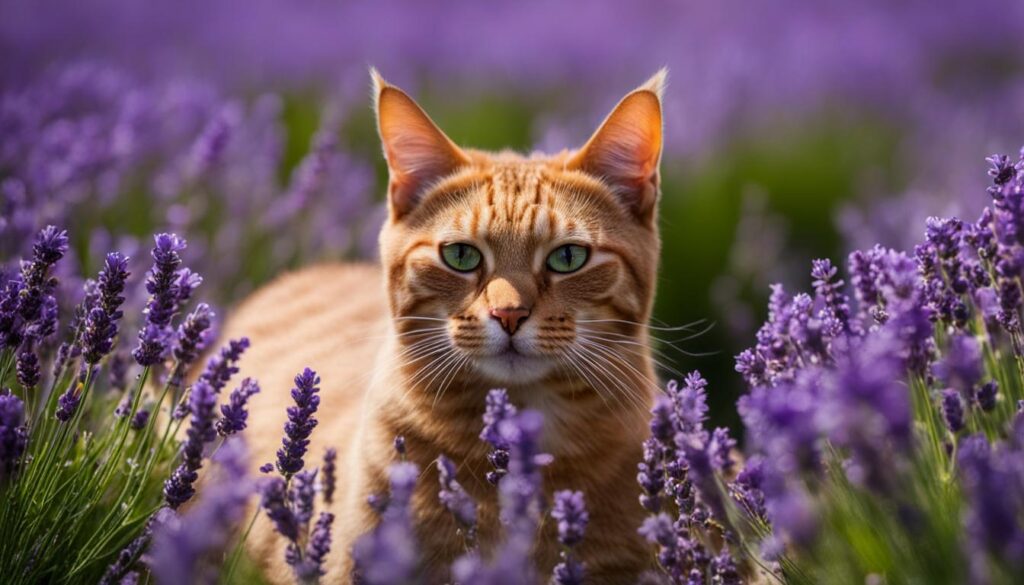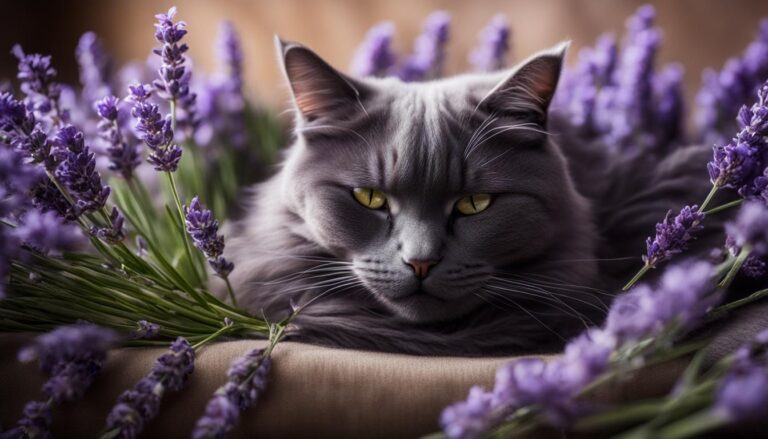When it comes to the well-being of our feline friends, it’s important to be mindful of their safety and health. One question that often arises is whether lavender is safe for cats. Lavender, known for its soothing fragrance and numerous uses in essential oils and natural remedies, may seem harmless. However, it is essential to understand the potential risks and implications for our beloved feline companions.
Основные выводы:
- Lavender is considered toxic to cats due to chemical compounds.
- Linalool and linalyl acetate in lavender can irritate cats’ skin, eyes, and more.
- Cats can be exposed to lavender through ingestion, inhalation, or contact.
- While lavender exposure may not be fatal, it can cause discomfort and require veterinary attention.
- To keep your cat safe, avoid lavender plants, essential oils, and products containing lavender.
Lavender and Cats: Understanding the Risks
Lavender is considered toxic to cats, according to the ASPCA Poison Control Center. The chemical compounds linalool and linalyl acetate present in lavender can irritate cats’ skin, eyes, mucous membranes, and gastrointestinal tracts. These chemicals are metabolized in the liver and may cause liver damage. Cats can be exposed to lavender by ingesting the plant, inhaling or licking the essential oil, or coming into contact with products that contain lavender. While lavender exposure is unlikely to be fatal, it can cause discomfort and require veterinary attention.
To better understand the risks associated with lavender and cats, it’s important to recognize the symptoms of exposure. Cats may experience lethargy, drooling, vomiting, loss of appetite, skin redness and inflammation, sneezing, wheezing, eye discharge, or excessive tearing. If any of these symptoms are observed, it is crucial to contact a veterinarian for proper diagnosis and treatment.
To ensure your cat’s safety, it is best to keep all forms of lavender away from them. This includes plants, dried lavender, lavender essential oil, and products that contain lavender. Additionally, be cautious of other dangerous ingredients that may be present in lavender products. Stick to veterinary-approved products that are known to be safe for cats. If you choose to have lavender plants in or around your home, make sure they are placed out of your cat’s reach to prevent them from nibbling on the plants and experiencing discomfort. Prioritizing your cat’s safety and avoiding lavender exposure is essential for their well-being.
Quotes
“Lavender exposure can cause various discomforting symptoms in cats, including skin irritation, gastrointestinal upset, and liver damage. It’s important for cat owners to understand the risks and take necessary precautions to keep their feline friends safe.” – Dr. Emily Collins, Veterinarian
Table: Symptoms of Lavender Toxicity in Cats
| Симптомы | Описание |
|---|---|
| Летаргия | Unusual tiredness or lack of energy |
| Drooling | Excessive saliva production or drooling from the mouth |
| Рвота | Forceful expulsion of stomach contents through the mouth |
| Loss of Appetite | Reduced or lack of interest in eating |
| Skin Redness and Inflammation | Redness, swelling, or irritation of the skin |
| Чихание | Repeated and sudden expulsion of air through the nose and mouth |
| Wheezing | High-pitched whistling sound produced while breathing |
| Eye Discharge | Abnormal fluid or discharge from the eyes |
| Excessive Tearing | Abnormal production of tears |
Remember, when it comes to your cat’s health, it’s always best to consult with your veterinarian for personalized guidance and recommendations. They can provide you with safe alternatives for calming your cat and address any concerns you may have about lavender exposure. By prioritizing your cat’s well-being and avoiding potentially harmful substances like lavender, you can help ensure they lead a happy and healthy life.
Effects of Lavender Exposure in Cats
When cats are exposed to lavender, whether through ingestion, inhalation, or contact with lavender products, they can experience a range of effects. These effects can vary depending on the amount of exposure and the individual cat’s sensitivity. It is important for cat owners to be aware of these potential effects and to take prompt action if their cat shows any signs of lavender toxicity.
Possible Symptoms of Lavender Exposure
- Летаргия
- Drooling
- Рвота
- Потеря аппетита
- Skin redness and inflammation
- Чихание
- Wheezing
- Eye discharge
- Excessive tearing
These symptoms can indicate irritation and discomfort resulting from lavender exposure. If you notice any of these symptoms in your cat, it is important to seek veterinary attention for a proper diagnosis and appropriate treatment.
“My cat started sneezing and had watery eyes after being around a lavender candle. I immediately contacted my veterinarian, who advised me to keep my cat away from any lavender products and monitored her for any further symptoms. Thankfully, with prompt action, she recovered without any complications.”
It’s worth noting that while lavender exposure is unlikely to be fatal, it can still cause significant discomfort and potentially lead to further health issues if left untreated. Therefore, it is crucial to ensure that your cat is not exposed to lavender in any form and to be vigilant in avoiding products that contain lavender.
Lavender Toxicity and Veterinary Care
If your cat has been exposed to lavender and is exhibiting symptoms, seeking veterinary care is vital. A veterinarian will be able to assess the severity of the exposure and provide appropriate treatment. Depending on the symptoms and the cat’s condition, the veterinarian may recommend supportive care, such as fluids to prevent dehydration, medication to alleviate symptoms, or further diagnostic tests to evaluate potential organ damage.
By understanding the effects of lavender exposure and being proactive in protecting your cat, you can ensure their health and well-being. Remember, if you suspect your cat has been exposed to lavender or any other potentially harmful substances, always consult with a veterinarian for expert guidance.
| Table: Common Symptoms of Lavender Exposure in Cats | |
|---|---|
| Симптомы | Possible Causes |
| Летаргия | Chemical irritants in lavender |
| Drooling | Chemical irritants in lavender |
| Рвота | Ingestion of lavender |
| Потеря аппетита | Gastrointestinal discomfort from lavender exposure |
| Skin redness and inflammation | Contact dermatitis from lavender |
| Чихание | Inhalation of lavender particles |
| Wheezing | Inhalation of lavender particles |
| Eye discharge | Eye irritation from lavender |
| Excessive tearing | Eye irritation from lavender |

Keeping Your Cat Safe from Lavender
If you want to ensure your cat’s safety, it’s important to take certain precautions when it comes to lavender. Here are some steps you can take to keep your furry friend away from this potentially harmful plant:
1. Keep lavender out of reach
Cats are curious creatures and may explore plants, so it’s best to keep lavender plants out of their reach. Place them in areas where your cat cannot access them, such as high shelves or hanging baskets. This will minimize the chances of your cat nibbling on the leaves or flowers and experiencing any discomfort.
2. Avoid lavender products
Be cautious of products that contain lavender, such as soaps, lotions, or candles. These products may also contain other ingredients that can be harmful to cats. Opt for cat-friendly alternatives and ensure that any products you use in your home are safe for your feline companion.
3. Explore cat-friendly alternatives
If you’re looking for ways to calm your cat, there are plenty of cat-friendly alternatives available. Consider using pheromone products, such as Feliway, which can help reduce stress in cats. Additionally, there are calming supplements made specifically for cats that can be helpful under veterinary supervision. Catnip is also known to have a calming effect on some cats. Consult with your veterinarian to find the best options for your cat’s specific needs.
By following these steps, you can help ensure that your cat stays safe from any potential harm associated with lavender. Prioritizing your cat’s well-being and using cat-friendly products will go a long way in keeping them happy and healthy.
| Tips for Keeping Your Cat Safe from Lavender |
|---|
| Keep lavender plants out of your cat’s reach |
| Avoid using products that contain lavender |
| Explore cat-friendly alternatives for calming your cat |
Safer Alternatives for Calming Your Cat
When it comes to calming your cat, there are several safe alternatives to lavender that you can consider. These natural remedies can help reduce stress and create a more relaxed environment for your feline friend.
Create a Calm Environment
Environmental enrichment is an important aspect of cat care. Provide your cat with plenty of opportunities to engage in natural behaviors and outlets for their energy. This can include providing scratching posts, interactive toys, and vertical spaces such as cat trees or shelves. These resources can help alleviate stress and promote a sense of security for your cat.

Consider Pheromone Products
Pheromone products, such as Feliway, are designed to mimic the natural pheromones that cats release when they feel safe and secure. These products come in the form of diffusers, sprays, or collars and can help reduce anxiety and create a calming effect for your cat. Consult with your veterinarian to determine the best pheromone product and application method for your cat’s needs.
Explore Calming Supplements
Calming supplements made specifically for cats can also be effective in reducing anxiety and promoting relaxation. Look for supplements that contain ingredients like L-theanine and thiamine, which are known to have calming properties. Remember to consult with your veterinarian before adding any supplements to your cat’s diet to ensure safety and proper dosage.
Incorporate Catnip
Many cats are attracted to the scent of catnip, which can have a calming effect on them. You can offer catnip toys or sprinkle dried catnip on scratching posts or bedding to provide a natural and enjoyable way for your cat to relax. Keep in mind that not all cats are affected by catnip, so it’s important to observe your cat’s reaction to ensure it has a positive effect.
Summary
While lavender is not safe for cats, there are several alternatives that can help calm your feline companion. Creating a calm environment, using pheromone products, exploring calming supplements, and incorporating catnip are all safe and effective ways to reduce anxiety and stress in cats. Remember to consult with your veterinarian for personalized guidance and recommendations to find the best calming option for your cat’s individual needs.
Заключение
Lavender is not safe for cats and can pose various risks to their health and well-being. It’s crucial to prioritize your cat’s safety by keeping all forms of lavender away from them. The chemical compounds found in lavender, such as linalool and linalyl acetate, can irritate the skin, eyes, mucous membranes, and gastrointestinal tracts of cats. Ingesting lavender or coming into contact with lavender products can lead to discomfort and may even cause liver damage.
To ensure your cat’s safety, it’s important to be mindful of the products you use in your home. Avoid using soaps, lotions, or candles that contain lavender, as they may also contain other harmful ingredients. Instead, opt for cat-friendly products that are known to be safe. Additionally, if you want to keep lavender plants around, make sure they are placed in areas that are inaccessible to your curious feline.
If you are looking for alternatives to calm your cat, there are safer options available. Environmental enrichment, including providing scratching posts, perches, and engaging playtime, can help create a low-stress environment for your cat. Pheromone products, calming supplements, and catnip can also have a calming effect on some cats. Remember to consult with your veterinarian for personalized guidance and recommendations tailored to your cat’s needs.
By understanding the risks associated with lavender and taking necessary precautions, you can ensure that your cat remains safe and healthy. Prioritizing their well-being and avoiding potentially harmful substances is essential for their overall health and happiness.




